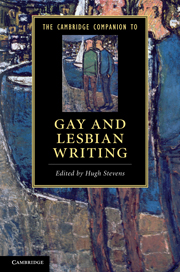Book contents
- Frontmatter
- Homosexuality and literature: an introduction
- Part I Repression and Legitimation
- 1 Homosexual writing on trial: from Fanny Hill to Gay News
- 2 Psychoanalysis, homosexuality and modernism
- 3 Lesbian modernism: writing in and beyond the closet
- 4 The erotics of transgression
- 5 Normality and queerness in gay fiction
- Part II Affiliations
- Part III Literary Traditions
- Guide to further reading
- Index
3 - Lesbian modernism: writing in and beyond the closet
from Part I - Repression and Legitimation
Published online by Cambridge University Press: 28 January 2011
- Frontmatter
- Homosexuality and literature: an introduction
- Part I Repression and Legitimation
- 1 Homosexual writing on trial: from Fanny Hill to Gay News
- 2 Psychoanalysis, homosexuality and modernism
- 3 Lesbian modernism: writing in and beyond the closet
- 4 The erotics of transgression
- 5 Normality and queerness in gay fiction
- Part II Affiliations
- Part III Literary Traditions
- Guide to further reading
- Index
Summary
The closet describes the private, hiding space in which lesbians and gay men who will not admit publicly to their sexual identity either reside or put their dissident sexuality. In his book Gay New York: Gender, Urban Culture, and the Making of the Gay Male World, 1890-1940, George Chauncey describes the closet as 'the spatial metaphor typically used to characterize gay life before the advent of gay liberation as well as their own lives before they “came out.”' He argues that the origins of the term remain 'obscure' but speculates that its usage derives originally from the notion of 'the skeleton in the closet' and thus evokes the notions of secrecy, shame, abjection and surveillance which all constellate around the concept, as used both in dominant heterosexual culture and by lesbians and gay men themselves. Historically, the term comes into use after the Stonewall riots in New York City in June 1969. Undoubtedly, since the advent of the gay liberation movement the closet has accrued substantial power as a signifier in both cultural and political terms. The metaphor of the closet has been extended by attendant terminology, principally the notion of 'coming out' - now shorthand for a subject's articulation of their sexuality - which derives from the notion of opening the closet door and stepping out into the public world. In contemporary lesbian and gay subcultures, the term has developed so that it now functions as a noun, the 'closet', as well as an adjective which describes subjectivity, 'closeted', and even a taxonomy of different subject-types, amongst others, the 'closet queen', the 'closet case', the 'closet Tommy' and the 'closet dyke'.
- Type
- Chapter
- Information
- The Cambridge Companion to Gay and Lesbian Writing , pp. 50 - 64Publisher: Cambridge University PressPrint publication year: 2010
- 3
- Cited by



